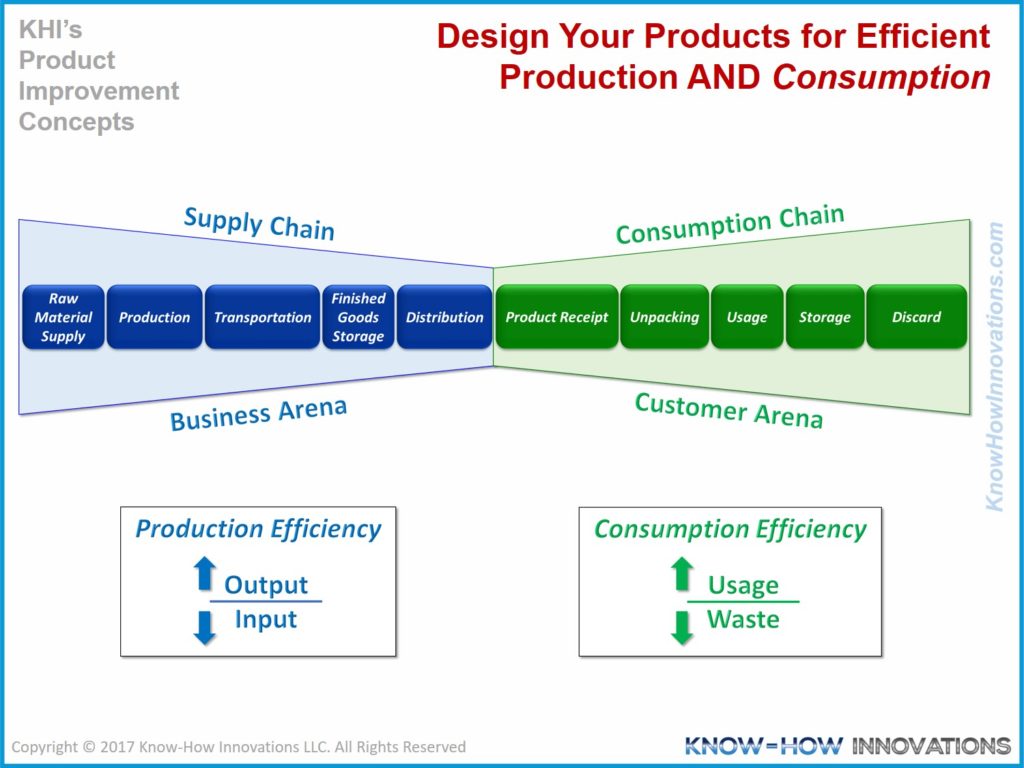Your Customers Care About Consumption Efficiency. Do You?
March 8, 2018
Your Customers Care About Consumption Efficiency. Do You?
by Rishab Rao
“A satisfied customer is the best business strategy of all.” – Michael LeBoeuf
Efficient mass production produces mass waste efficiently!
Do not become efficient…unless your efficiency extends throughout the customer’s experience with your products. We tend to think of efficiency in terms of an output to input ratio. The greater the output per unit of input, the more efficient you are. In other words, the more you produce for less, the greater your efficiency is said to be. This applies to all products whether hard (consumer products, electronics, pharmaceuticals, gasoline, etc.) or soft (software, information, electronic messages, emails, energy, etc.). How much thought have you given to the Consumption Efficiency of your products?
As production processes have become more efficient through the application of business improvement methodologies like TQM1, Lean Enterprise Management2, Six Sigma3, and TOC4, among others, they have begun producing products in greater quantities and in shorter periods of time. Production efficiency results in three major benefits: lower prices for the consumer, quicker delivery to customers, and greater quantities of the product for a larger market. These are all great things in the interim, but this model is not sustainable in the long run. It is one innovative competitor away (or one environmental regulation away) from being sent into a disruption5 spiral.
Production efficiency has been the center of focus for over a century, yet consumption efficiency is only just beginning to surface as a factor of importance in market survivability. What happens to your products after they are delivered to your customers? How are they being used, stored, and eventually discarded? How much disposed waste do your products eventually contribute?
Production Efficiency
Production efficiency is generically defined as the quantity of non-defective output per unit input. On-Time Delivery is a metric often used to gauge efficiency. This metric has the underlying implication that efficiency does not matter beyond the product being delivered to the customer on time.
Production efficiency alone is an illusion, and industry disruption lurks menacingly in the murky depths of the market upon which you navigate your business, waiting to rise up to devour and grind your business into a statistic of obsolescence.
Streamlining the production process, the period between start-of-production and end-of-delivery, is making only a limited spectrum of the entire supply chain6 efficient. What becomes of your product after delivery?
Consumption Efficiency
There are two equally important sides of a supply chain: Production (Supply) and Consumption (Demand). The equation to determine efficiency must consider both parts. Production Efficiency (Output / Input) and Consumption Efficiency (Usage / Waste).
Consumption efficiency is defined as the total usage of the product (the duration of use and/or the number of uses the customer gets out of the product before discard, i.e., one time use and discard or use and store multiple times) divided by the total discard waste that the product produces when it and its packaging are discarded.
Greater consumption efficiencies result in lower quantities of discarded waste per use of the product. To achieve consumption efficiency much thought and planning must be put into the end-to-end supply chain. The consumption process must be considered from the beginning, when designing the product and its packaging, not as an afterthought.
Supply-Consumption Chain
Traditionally the end-to-end process from production to distribution of goods was referred to as the Supply Chain. This chain ended at the customer with no visibility into the customer’s experience with the products. The Supply–Consumption Chain however, includes all aspects of the customer’s experience with the product, all the way up to the point that the product is discarded.
Source: Product Improvement for Market Growth
Improving the Consumption Chain
Give Back Box®, in partnership with Amazon, devised a clever solution for dealing with waste produced at the end of the consumption chain. Globally, consumers spend almost $2.5 trillion ($2,500,000,000,000) annually buying products online7. The majority of those products arrive in cardboard boxes, the majority of which end up being discarded. Give Back Box® and Amazon offer free shipping and easy, at-home printing of shipping labels for those boxes when customers wish to donate old household goods to the nearest charitable organization8.
Critics have stated that this is not a complete solution because those boxes eventually get discarded as well. Perhaps, but it is a decisive step in the right direction. This indicates that there is a keen focus on the consumption chain. Over time the solutions will become more ingenious and comprehensive. Customers seek solutions with greater consumption efficiency. They prefer products that require less effort to use, last longer, and produce less waste.
Consumption efficiency must become an important factor when first designing the product. It is less effective as an afterthought. Improving consumption efficiency has the leverage to disrupt markets by offering more complete solution for your customers. Currently it is left up to the customer to get creative with what they do with their old, no longer needed products. Sure, Craigslist is one solution, but it is not without effort and harbors a degree of risk. There are a number of motivations—from being environmentally responsible to charitable—that drive customers to take the effort to appropriately discard used products. The better you understand your customers’ motivations and desires, and the better you can address these factors, the greater your product’s consumption efficiency will be and the more the customers will gravitate toward your products, increasing your market share.
Definitions and References:
- http://asq.org/learn-about-quality/total-quality-management/overview/overview.html
- https://www.lean.org/WhatsLean/
- https://www.isixsigma.com/new-to-six-sigma/getting-started/what-six-sigma/
- https://www.tocinstitute.org/theory-of-constraints.html
- https://hbr.org/2015/12/what-is-disruptive-innovation
- https://en.wikipedia.org/wiki/Supply_chain
- https://www.invespcro.com/blog/global-online-retail-spending-statistics-and-trends/
- https://www.amazon.com/p/feature/xde6cauvpfp66o2
